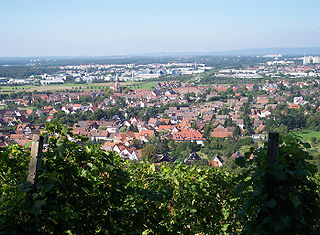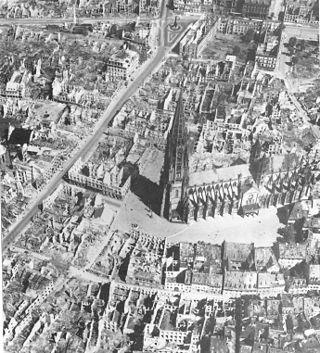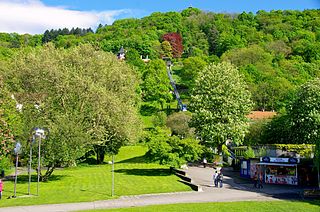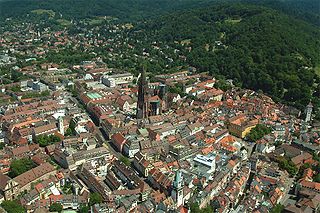Breisgau-Hochschwarzwald is a Landkreis (district) in the southwest of Baden-Württemberg, Germany. Fifty towns and municipalities with 133 settlements lie within the district. The district itself belongs to the region of Freiburg with the region of Southern Upper Rhine.

Haslach im Kinzigtal is a small city in the Black Forest in the district Ortenaukreis, Baden-Württemberg in south-western Germany. In 2015, it comprised a population of 6,893 inhabitants.

St. Ulrich's Priory in the Black Forest was a priory of Cluny Abbey founded in the valley of the River Möhlin in the Black Forest in about 1083. St. Ulrich is now part of the municipality of Bollschweil, in the district of Breisgau-Hochschwarzwald, Baden-Württemberg, Germany.

Freiburg-St.Georgen is a district of the German city Freiburg and consists of three villages: Uffhausen, Wendlingen and Sankt Georgen itself. Sankt Georgen became a part of Freiburg in 1937. It is bordered by the Schönberg in the South, Merzhausen to the South-East, the Wiehre to the East, Haslach to the North-West and the Rieselfeld to the North-East. To the South-West it borders Schallstadt and Opfingen and Tiengen to the West.

Rieselfeld is a city quarter (Stadtteil) in Freiburg im Breisgau. It is located in the western part of the city and borders the nature reserve Freiburger Rieselfeld in the west, right next to a little zoo called Tiergehege Mundenhof, Opfinger Straße in the south and Besançonallee in the east. The industrial area Haid is part of the Sankt Georgen district and is located to the south of Rieselfeld, while the district Weingarten is situated to the east of Rieselfeld.
Haslach is a German word derived from Old High German hasala ("hazel") and aha. It may refer to:

Operation Tigerfish was the military code name in World War II for the air raid on Freiburg in the evening of 27 November 1944 by the Royal Air Force with about 2,800 dead.

The Freiburg im Breisgau tramway network is a network of tramways that forms part of the public transport system in Freiburg im Breisgau, a city in the federal state of Baden-Württemberg, Germany. Established in 1901, the network has been operated since its foundation by the company now known as Freiburger Verkehrs, and powered by electricity. The tramway network currently has five lines. The expansion of the tram network since 1980 has served as an example of the "renaissance of the trams" in Germany. As of 2023, 73 trams were available for regular use: 2 of these were high-floored, 36 partial and 35 low-floored. Almost the entirety of the network is located within Freiburg's urban area; only a few metres of the balloon loop at Gundelfinger Straße are located outside the boundary of Gundelfingen to the north of Freiburg. In total, the trams serve 20 out of the 28 districts in Freiburg.

The Kaiser-Joseph-Straße in Freiburg im Breisgau is a shopping street of about 900 meters, which runs through the center of Freiburg's historic downtown from north to south. It is one of the most expensive locations in Germany.

The Central Black Forest, also called the Middle Black Forest, is a natural or cultural division of the Black Forest in Baden-Württemberg in Germany. It generally refers to a region of deeply incised valleys from the Rench valley and southern foothills of the Kniebis in the north to the area of Freiburg im Breisgau and Donaueschingen in the south. Its highest area, which is southeast of the Elz valley, is also part of the High Black Forest.

Freiburg im Breisgau's parks, green spaces, recreational facilities, playgrounds, roadside greeneries and the Mundenhof add up to an area of 397 ha (3.97 km2), which corresponds to 18.05 m2 of green space per Freiburg citizen. On average, major cities in Baden-Württemberg have 22.66 m2 green space/citizen. However, there is an area of 2600 ha (26 km2) of forest in the close proximity of Freiburg as well as additional recreational area like the Rieselfeld district. The majority of the green spaces came into existence from the 1960s on.

Weingarten is a municipal district of Freiburg im Breisgau. In the north, it is separated by the river Dreisam from the district Betzenhausen, in the east beyond the rail tracks lies Haslach and in the south, separated by the Opfinger Road, the district Haslach-Haid. In the west, the new district Rieselfeld borders Weingarten.
The Salzstraße in Freiburg im Breisgau is a significant part of the Freiburg city centre pedestrian area. It runs from Bertoldsbrunnen to Kaiser-Joseph-Straße, then eastward to Oberlinden square, where a fountain of the same name is located. It is probably the location of Freiburg's oldest houses. A stream, the Freiburg Bächle, runs along the street's northern side between the tramway tracks and the pavement.

The Stadtgarten of Freiburg is a 2.6 ha park within the Neuburg district. It has an old tree grove and a large rose garden, and lies between the Leopoldring, Jackob Burckhardt, Ludwig and Mozart streets near Freiburg's city centre. It is connected to Karlsplatz via the Karlssteg footbridge, which is made from pre-stressed concrete. Since 2008 the Schlossberg Tram, an inclined elevator, leads up to Schlossberg. It replaced the Schlossberg Cable Car built in 1968.
Mooswald is a district in the western part of Freiburg im Breisgau, Germany, which consists of the two districts Mooswald West (521) and Mooswald East (522). Its population is 9,223 (2020). In the North East, Mooswald borders the district of Brühl, with its airfield, the university campus of the technical faculty and the exhibition centre. Mooswald further borders the district of Landwasser in the North West, the district of Stühlinger in the East and the district of Betzenhausen with the Seepark in the South West. Mooswald is separated from Brühl by the Breisgau S-Bahn, from Landwasser by the Westrandstraße (Paduaallee/Mooswaldallee) and from Stühlinger by the railway tracks of the freight railway.

The Old City of Freiburg is part of the city and business centres of Freiburg im Breisgau and is the core of the original city. It is divided into the two districts 111 Altstadt-Mitte and 112 Altstadt-Ring. The Altstadt-Mitte district was the city's build-up area at the time of its foundation and therefore formed the old city. The district Altstadt-Ring is connected westwards to the railway line and south to the Dreisam.

The Platz der Alten Synagoge is a square in Freiburg, Germany. With a size of 130 square metres, it is the second largest square in the city after Minster Square. The square is named after the old synagogue, which was destroyed during the Kristallnacht in 1938. The synagogue had been built in 1869/1870 to the southwest of today's location of the square.

Cobblestone mosaics can be found throughout Freiburg im Breisgau. Most mosaics are embedded in the cobblestone pavement of the city centre of Freiburg.

Betzenhausen is a quarter in the west of Freiburg im Breisgau, Germany. It consists of the statistical districts Alt-Betzenhausen and Betzenhausen-Bischofslinde.
Bruno Lenz was a German painter and violinist. He was assistant concertmaster for 20 years of the Bavarian Radio Symphony Orchestra.

















